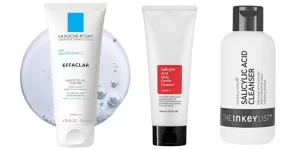
If you’re a tattoo enthusiast (or thinking about getting your first one), you know ( or you’re about to find out) how important it is to take good care of your ink.
After all, you don’t want to end up with a faded, infected, or scarred piece of art on your skin, right?
That’s why moisturizing is a crucial step in tattoo aftercare. It helps your tattoo heal faster, prevent dryness and itching, and keeps your colors vibrant and beautiful.
But, with so many moisturizing products out there, how do you choose the best one for your tattoo?
Well, let’s compare two of the most popular ones: Aquaphor and Lubriderm.
These are both dermatologist-recommended products that many tattoo artists swear by.
But, which one is better for your tattoo?
Is Aquaphor or Lubriderm better for tattoos? And how do you use them properly?

Let’s discuss the benefits, drawbacks, usage tips, and alternatives for each product.
By the end of this post, you’ll have a clear idea of which one suits your tattoo needs better.
So, let’s get started!
| this post may contain affiliate links, which means if you purchase from one of these links, I may receive a small commission at no additional cost to you. |
What is Aquaphor and How Does It Work for Tattoos?
Aquaphor isn’t just a regular moisturizer.
It’s an ointment that creates a protective barrier on your skin and locks in moisture.
This way, it helps your tattoo heal faster and more comfortably while preventing dryness, scabbing, itching, and infection.
Aquaphor contains some amazing ingredients that have soothing, anti-inflammatory, and healing properties for your skin. Like:
Petrolatum – This is the main ingredient in Aquaphor, and it works by forming a semi-occlusive layer on your skin that prevents water loss and allows oxygen to reach the wound.
Lanolin – This is a natural wax derived from sheep’s wool, and it helps soften and smooth your skin, as well as reduce inflammation and irritation.
Glycerin – This is a humectant that attracts water from the air and binds it to your skin, keeping it hydrated and plump.
Bisabolol – This is a component extracted from the chamomile plant, and it has soothing, anti-inflammatory, and antibacterial properties.
It also helps promote skin regeneration and wound healing.
Aquaphor isn’t just recommended by me, but also by other reputable sources that know a thing or two about tattoos.
That’s because it has hydrating and anti-inflammatory properties that can speed up healing and make the process more comfortable and because of its anti-inflammatory properties.
Some of the advantages of using Aquaphor for tattoos are:
Faster healing – Aquaphor helps your skin repair itself faster by providing moisture, oxygen, and nutrients to the wound.
It also prevents scabs from forming, which can slow down the healing process and damage your tattoo design.
Reduced scabbing and itching – Aquaphor keeps your skin soft and supple, reducing the chances of scabbing and cracking.
It also soothes your skin and relieves the itchiness that accompanies tattoo healing.
Prevention of infection – Aquaphor acts as a barrier against bacteria, dirt, and other contaminants that can cause infection.
It also contains bisabolol, which has antibacterial properties and helps fight off germs.
Drawbacks of Aquaphor for Tattoos
Aquaphor may sound like a miracle product for tattoos, but it’s not perfect.
There are some potential disadvantages of using it for tattoos that you should be aware of, like:
Clogging pores – Aquaphor, being a thick and heavy ointment, has the potential to clog pores and cause breakouts, especially if your skin is sensitive or acne-prone.
This can result in irritation, inflammation, and even infection of your tattoo.
Causing allergic reactions – Aquaphor contains some ingredients that may cause allergic reactions in some people, such as lanolin, mineral oil, and bisabolol.
These reactions can vary from mild rashes to severe swelling and itching.
If you notice any signs of an allergic reaction, please discontinue the use of Aquaphor immediately and consult your doctor.
Staining clothes and sheets – Aquaphor is an oily product that can stain your clothes and sheets if you don’t properly cover your tattoo.
This can be quite annoying and costly, especially if you have expensive or delicate fabrics.
To avoid this, make sure you use a clean bandage or wrap over your tattoo when you use Aquaphor, and change it regularly.
Being too greasy or heavy – Aquaphor is a greasy product that can make your skin feel sticky and uncomfortable.
It can also be too heavy for your tattoo, especially after the first few days of healing.
Using too much or applying it too frequently can interfere with the tattoo’s healing process by suffocating the skin or trapping bacteria.
Another thing to avoid is using petroleum jelly or Vaseline instead of Aquaphor.
These products are not the same as Aquaphor and can hinder the healing process of your tattoo, potentially leading to infection.
This is because they are 100% petroleum-based, which restricts airflow to the skin.
They also don’t contain any other ingredients that help with healing, soothing or moisturizing.
So, how can you avoid or minimize the drawbacks of Aquaphor?
Here are some tips:
Use a thin layer – You don’t need to slather your tattoo with Aquaphor. Just apply a thin layer to keep it moisturized and protected.
Using too much can clog your pores, stain your clothes and sheets, and slow down the healing process.
Apply it sparingly – You don’t have to apply Aquaphor every hour or after every time you wash your tattoo.
Two to three times a day is sufficient for the first few days of healing.
Applying it too frequently can make your skin greasy, heavy, and hinder its ability to breathe.
Switch to lotion after a few days – You don’t have to use Aquaphor for the entire healing period of your tattoo.
After a few days to a week, you can switch to a lighter, unscented, and hypoallergenic lotion like a daily lotion from Cetaphil, Cerave, Lubriderm or maybe Dove.
This will provide sufficient moisture for your tattoo without leaving it feeling too oily or heavy.
Patch test before use – You don’t want to find out that you’re allergic to Aquaphor after you’ve applied it to your tattoo.
To avoid this, do a patch test before use by applying a small amount to a hidden area of your skin and waiting for 24 hours.
Then if you don’t see any signs of an allergic reaction, you can use it on your tattoo.
What is Lubriderm and How Does It Work for Tattoos?
Lubriderm is another lotion often recommended for tattoo aftercare.
It works by hydrating and nourishing the skin with gentle and effective water-based ingredients and contains moisturizing, soothing, and healing properties for your skin.
Some of these ingredients are:
Glycerin – This is a humectant that attracts water from the air and binds it to your skin, keeping it hydrated and plump.
Dimethicone – This is a silicone-based emollient that forms a protective layer on your skin that prevents water loss and reduces friction.
Panthenol – This is a form of vitamin B5 that helps repair damaged skin cells and improve skin elasticity and smoothness.
Vitamin E – This is an antioxidant that protects your skin from free radical damage and promotes wound healing.

Some of the advantages of using Lubriderm for tattoos are:
Lighter texture – Lubriderm is a lotion, not an ointment, which means it has a lighter texture that feels more comfortable on your skin.
It won’t leave a greasy or sticky residue and absorbs quickly into your skin.
Easier absorption – Lubriderm lotion is water-based, which means it penetrates deeper into your skin layers and delivers more moisture to your tattoo.
It also allows more air to reach your skin, which helps with healing and breathing.
Longer-lasting hydration – Lubriderm claims it can help to moisturize your skin for 24 hours.
This means you don’t have to apply it as often as other lotions from other brands, and you can enjoy longer-lasting hydration for your tattoo.
Prevention of dryness and cracking – Lubriderm helps prevent your tattoo from drying out and cracking, which can damage your tattoo design and cause infection.
It also helps relieve the itchiness and flakiness that come with tattoo healing.
Drawbacks of Lubriderm for Tattoos
Lubriderm may sound like a great lotion for tattoos (and it is), but it’s not without its drawbacks.
There are some potential disadvantages of using Lubriderm for tattoos that you should be aware of.
Some of these are:
Contains alcohol, fragrance, and other additives – Lubriderm comes in different formulas, some of which may contain alcohol, fragrance, or other additives that can irritate or inflame the skin.
Alcohol can dry out the skin and cause stinging or burning sensations, while fragrance or other additives can cause allergic reactions or rashes.
If you have sensitive skin or allergies, you should choose an unscented or sensitive skin formula of Lubriderm.
Using Lubriderm too soon after getting a tattoo – Lubriderm is a lotion, not an ointment, which means it’s not as thick or protective as Aquaphor.
Using Lubriderm too soon after getting a tattoo can cause stinging or burning sensations or damage the ink.
You should wait until your tattoo is healed enough to use lotion, which is usually after a few days to a week.
Using expired or contaminated lotion on your tattoos – Lubriderm, like any other lotion, can expire or get contaminated over time.
Using expired or contaminated lotion on your tattoos can cause infection or allergic reactions. You should always check the expiration date and the condition of the lotion before using it on your tattoos.
You should also store the lotion properly, away from heat, light, and moisture.
So, how can you avoid or minimize the drawbacks of Lubriderm?
Here are some tips:
Choose an unscented or sensitive skin formula – If you have sensitive skin or allergies, you should avoid using Lubriderm formulas that has alcohol, fragrance, or other additives that can irritate or inflame your skin.
Instead, choose an unscented or sensitive formula that’s gentle and hypoallergenic.
Wait until your tattoo is healed enough to use lotion – You don’t want to use Lubriderm too soon after getting a tattoo, as it can cause stinging or burning sensations or damage the ink.
You should wait until your tattoo is healed enough to use lotion, which is usually after a few days to a week.
Until then, you can use an ointment like Aquaphor to keep your tattoo moisturized and protected.
Check the expiration date and the condition of the lotion – You don’t want to use expired or contaminated lotion on your tattoos, because it can cause an infection or allergic reactions.
You should always check the expiration date and the condition of the lotion before using it on your tattoos.
You should also store the lotion properly, away from heat, light, and moisture.
The Best Aquaphor and Lubriderm Products for Tattoos
You’ve decided to use Aquaphor and Lubriderm for your tattoos, but which products should you use?
Both brands have multiple products on the market, but not all of them are suitable for tattoo aftercare.
Here are some of the best Aquaphor and Lubriderm products for tattoos, based on their ingredients, reviews, and popularity.
The Best Aquaphor Products for Tattoos
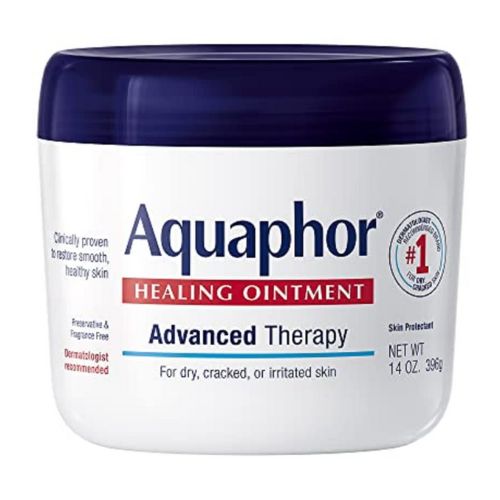
This is the classic product that most tattoo artists and enthusiasts recommend for tattoo aftercare.
It contains petrolatum, lanolin, glycerin, panthenol, and bisabolol which work together to moisturize, protect, soothe, and heal the skin.
It forms a semi-occlusive barrier that prevents infection and scabbing, while still allowing oxygen to reach the wound. It’s fragrance-free, preservative-free, and hypoallergenic.
You can use it for the first few days to a week after getting a tattoo, and then switch to a lotion.
Aquaphor Baby Healing Ointment
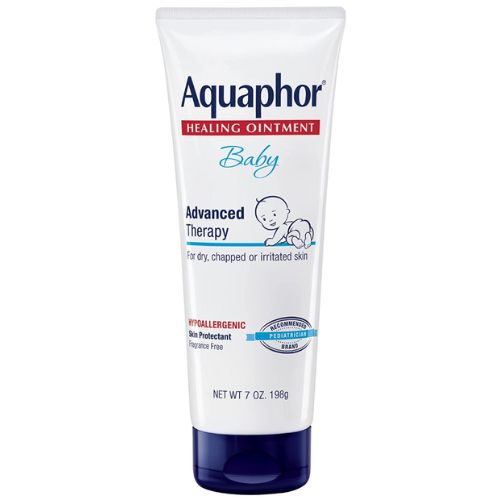
This is a variant of the original product that is specially designed for babies sensitive skin.
It contains the same ingredients as the original product but in different proportions.
It’s fragrance-free, preservative-free, hypoallergenic and it’s gentle enough to use on your tattoo, especially if you have sensitive or allergic skin.
You can use it for the same duration as the original product, then switch to a lotion.
The Best Lubriderm Products for Tattoos
Lubriderm Daily Moisture Hydrating Unscented Body Lotion
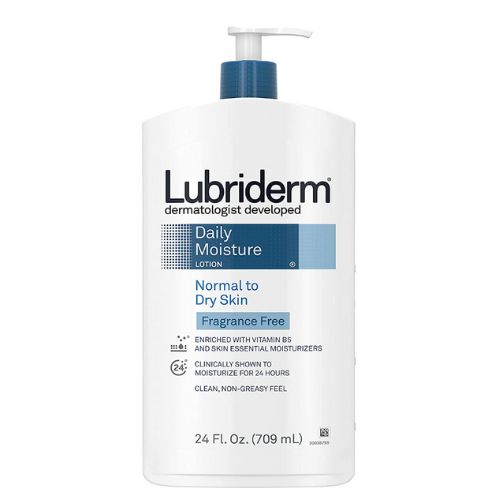
This is one of the most popular lotions for tattoo aftercare.
It has water, glycerin, mineral oil, petrolatum, dimethicone, panthenol, and vitamin E, which help hydrate and nourish the skin.
It has a lightweight texture that absorbs quickly and doesn’t leave any greasy residue.
It’s fragrance-free, dye-free, and non-comedogenic.
You can use it once you stop using Aquaphor or another ointment until your tattoo is fully healed.
You can also continue to use it to maintain your tattoo’s health and appearance. Check the price on Amazon
Lubriderm Daily Moisture Lotion for Sensitive Skin
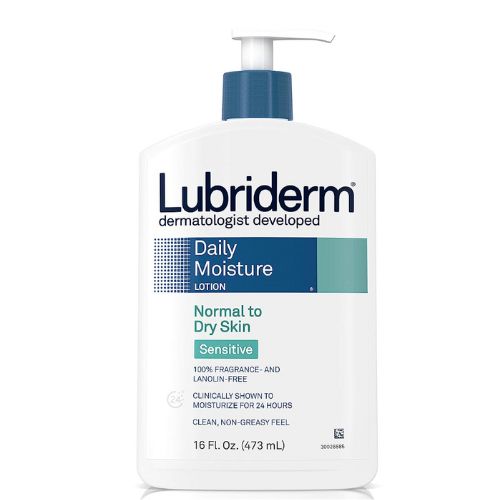
This is another variant of the original product that’s specially designed for sensitive skin.
It has the same ingredients as the original product but without lanolin or parabens.
It’s fragrance-free, dye-free and non-comedogenic, and gentle enough to use on your tattoo, especially if you have sensitive or allergic skin.
You can use it for the same duration as the original product until your tattoo is fully healed.
You can also continue to use it to maintain your tattoo’s health and appearance.
These are some of the best Aquaphor and Lubriderm products for tattoos that you can find online or in stores.
However, you should always check the labels and reviews of any product before using it on your tattoo.
You should also consult your tattoo artist for their recommendations and approval.
Usage Tips for Aquaphor and Lubriderm for Tattoos
Caring for a new tattoo isn’t really rocket science, but it does require some attention and dedication.
You want to make sure your tattoo heals properly and looks amazing for years to come.
Here are some general guidelines on how to care for a new tattoo:
Keep it clean – Wash your tattoo gently with unscented, antibacterial soap and lukewarm water at least twice a day.
Pat it dry with a clean paper towel and avoid rubbing or scratching it.
Avoid sun exposure – Sunlight can fade your tattoo and cause inflammation and infection.
Keep your tattoo covered or out of direct sunlight until it’s fully healed.
After that, always apply sunscreen with SPF 30 or higher when going outside.
Don’t scratch or pick at it – Your tattoo will itch and flake as it heals, but resist the urge to scratch or pick at it.
This can damage your tattoo design and cause scarring or infection.
Instead, apply some moisturizer or ointment to soothe the itchiness.
Follow the instructions of your tattoo artist – Your tattoo artist knows best how to care for your specific tattoo.
Follow their aftercare instructions carefully and don’t hesitate to contact them if you have any questions or concerns.
Now that you know the basics of tattoo aftercare, let’s talk about how to use Aquaphor and Lubriderm for tattoos.
These are two of the most popular products for tattoo aftercare, but they have different purposes and usage methods.
Here is some specific advice on how to use Aquaphor and Lubriderm for tattoos:
When to start and stop using them – You should start using Aquaphor as soon as you remove the bandage or wrap from your tattoo, which is usually after several hours to several days, depending on your tattoo artist’s instructions.
You should use Aquaphor for the first few days to a week of healing, then switch to Lubriderm or another lotion.
You should use lotion until your tattoo is fully healed, which is usually after 3 to 4 weeks.
How much and how often to apply them – You should apply a thin layer of Aquaphor two to three times a day for the first few days to a week of healing.
You don’t need to apply too much, as this can clog your pores and slow down the healing process.
You should apply Lubriderm or another lotion three to four times a day for the rest of the healing period.
You don’t need to apply too little, as this can dry out your skin and cause cracking or fading.
How to combine them in a routine – You should always wash your tattoo with soap and water before applying Aquaphor or Lubriderm.
This will remove any dirt, bacteria, or dead skin cells that can interfere with the healing process.
You should also always dry your tattoo by patting it with a paper towel before applying Aquaphor or Lubriderm.
This will prevent any moisture from diluting the products or causing infection.
To give you some examples of how to use Aquaphor and Lubriderm for tattoos based on different scenarios, here are some possible routines:
For a small, simple tattoo on your arm – You can remove the bandage after 4 hours and wash your tattoo with soap and water.
Apply a thin layer of Aquaphor and cover it with a clean bandage or wrap. Repeat this process twice a day for 3 days, then switch to Lubriderm or another lotion.
Apply lotion three times a day for 3 weeks, then continue as needed.
For a large, detailed tattoo on your back – You can keep the bandage on overnight and wash your tattoo with soap and water in the morning.
Apply a thin layer of Aquaphor and cover it with a clean bandage or wrap.
Repeat this process twice a day for 5 days, then switch to Lubriderm or another lotion.
Apply lotion four times a day for 4 weeks, then continue as needed.
For a colorful, intricate tattoo on your leg – You can remove the bandage after 6 hours and wash your tattoo with soap and water.
Apply a thin layer of Aquaphor and cover it with a clean bandage or wrap.
Repeat this process twice a day for 7 days, then switch to Lubriderm or another lotion.
Apply lotion four times a day for 4 weeks, then continue as needed.
Remember, these are just examples and not rules. Your tattoo artist may have different recommendations based on your specific tattoo and skin type.
Always follow their instructions and consult them if you have any doubts or issues.
I hope this post has helped you learn more about how to use Aquaphor and Lubriderm for tattoos.
These are great products that can help your tattoo heal faster and more comfortably while keeping it moisturized and protected.
Just make sure you use them correctly and safely and enjoy your new ink!
FAQ
Can I use Aquaphor and Lubriderm together?
Yes, you can use Aquaphor and Lubriderm together in a tattoo aftercare routine.
Just don’t use them at the same time or on top of each other.
Instead, use Aquaphor for the first few days after getting a tattoo to protect it from infection and scabbing.
Then, you should switch to Lubriderm to keep it hydrated and prevent dryness and cracking.
You can also alternate between them depending on what your skin needs.
How long should I use Aquaphor or Lubriderm for my tattoo?
This depends on a few things, such as the size, location, and style of your tattoo, your skin type, its condition, and your personal preference.
Generally, you should use Aquaphor for about 3 to 5 days after getting a tattoo, or until it starts to peel or flake.
Then, you should use Lubriderm for about 2 to 3 weeks, or until your tattoo is fully healed.
You can also continue to use Lubriderm or another moisturizer (like Cetaphil) to maintain the health and appearance of your tattoo.
What are some alternatives to Aquaphor or Lubriderm for tattoos?
There are many other products you can use for tattoo aftercare besides Aquaphor or Lubriderm.
And some, like Hustle Butter Deluxe Tattoo Aftercare Balm or After Inked Tattoo Moisturizer and Aftercare Lotion, are specially made for tattoos.
There are also natural or organic products that offer similar benefits, like coconut oil or shea butter.
However, check the ingredients and reviews of any product before using it on your tattoo, and also a good idea to consult with your tattoo artist for their recommendations and approval.
So is Aquaphor or Lubriderm Better for Tattoos?
Honestly, you can’t really compare the two because they don’t do the same things.
And it’s not so much “Is one better, which one should I use?” ( you can actually use both, just not at the same time) but “Which one should I use when?”
Getting a tattoo is a big deal, so you want to make sure you take good care of it.
And you can’t go wrong if you choose products from Aquaphor or Lubriderm.
They can help your tattoo heal faster and more comfortably while keeping it moisturized and protected.
Now go show off your new ink and enjoy it!😊


